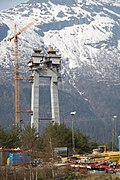Hardanger Bridge Hardangerbrua | |
|---|---|
 View of the bridge seen from the east | |
| Coordinates | 60°28′46″N6°49′53″E / 60.47944°N 6.83139°E |
| Carries | |
| Crosses | Hardangerfjorden |
| Locale | Ullensvang and Ulvik, Vestland, Norway |
| Maintained by | Norwegian Public Roads Administration [1] |
| Characteristics | |
| Design | Suspension bridge |
| Total length | 1,380 metres (4,530 ft) [2] |
| Width | 20 metres (66 ft) [2] |
| Height | 201.5 metres (661 ft) [3] |
| Longest span | 1,310 metres (4,300 ft) [4] |
| Clearance below | 55 metres (180 ft) [2] |
| History | |
| Constructed by | MT Højgaard [2] |
| Construction start | February 2009 |
| Construction end | August 2013 |
| Statistics | |
| Toll | Yes |
| Location | |
 | |
The Hardanger Bridge (Norwegian : Hardangerbrua) is a suspension bridge across the Eidfjorden branch off of the main Hardangerfjorden in Vestland county, Norway. The bridge connects the municipalities of Ullensvang and Ulvik. It replaced a ferry connection between Bruravik and Brimnes, and thereby shortens the driving time between Oslo and Bergen. It has the longest suspension bridge span in Norway. [5]




